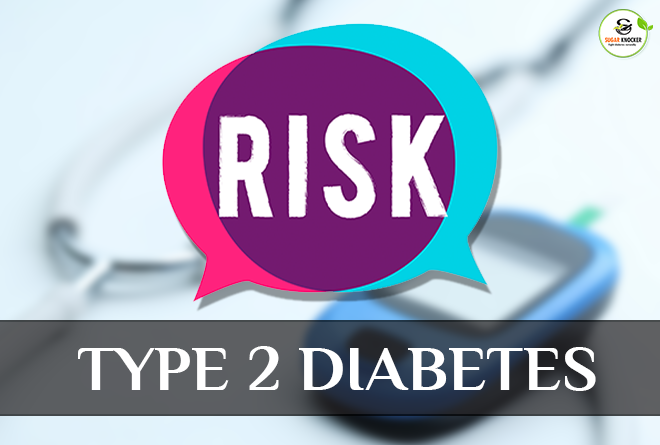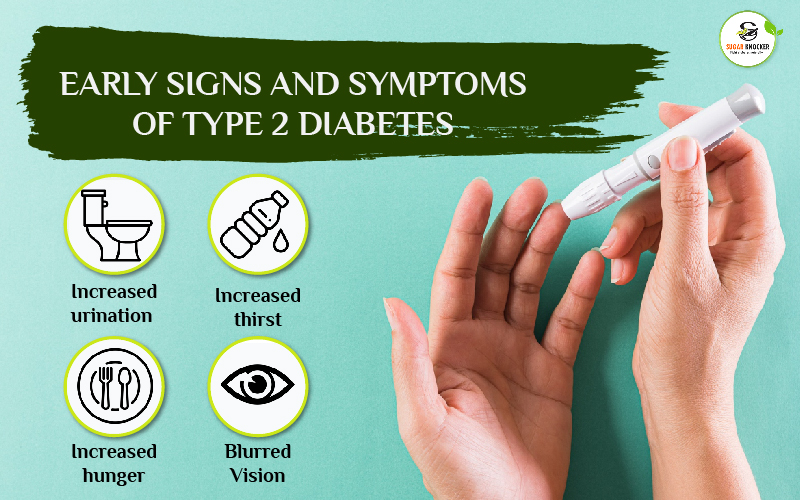
What are the risk factors for Type 2 Diabetes?
Type 2 diabetes is a metabolic disease that results in an elevation in blood glucose levels. Diabetes has a wide range of severity: many people have it under control, while others develop various health concerns as the condition progresses.
In type 2 diabetes, the pancreas produces insulin, but still, the body’s cells eventually lose their capacity to absorb and utilize it. Because type 2 diabetes is most often diagnosed later in life, it was previously referred to as “adult-onset” diabetes. Diabetes type 2 is far more frequent than diabetes type 1. Type 2 diabetes affects approximately 90% of persons with diabetes.
Introduction about Type 2 Diabetes

Your metabolism ensures that the sugar in your diet is appropriately dispersed throughout the body, ensuring that every one of our organs receives adequate sugar. Insulin is one of the hormones that is required for this mechanism to function correctly. The pancreas produces it. The sugar levels in your bloodstream rise when you consume food, and insulin is released into your system. Insulin helps cells in the muscles and liver tissues to absorb glucose from the blood. If insulin loses its ability to do this, the body will be unable to effectively use the sugar in the blood. The proportion of sugar in the blood rises as a result of this. Hyperglycemia is the clinical word for an abnormally elevated blood sugar level.
The pancreas generates adequate insulin in patients with type 2 diabetes, but it no longer has an impact on the body’s cells. Insulin resistance is the term used by doctors to describe this condition. For a short time, the pancreas may compensate by generating extra insulin. But eventually, the blood sugar levels begin to increase.
Type 2 diabetes is largely caused by two interconnected issues:
- Insulin resistance develops in muscle, fat, as well as liver cells.
- The pancreas would be unable to generate enough insulin to control blood glucose levels since these cells do not interact with insulin in the manner that they should.
Insulin’s mechanism of action
Insulin is a hormone produced by the pancreatic gland, which is located behind and just below the stomach (pancreas). Insulin controls the way sugar is used by the body in the following ways:
- The pancreas secretes insulin in response to sugar in the circulation.
- Insulin is a hormone that circulates in the circulation and allows sugar to enter cells.
- The level of sugar in your blood decreases.
- As a result of this decrease, the pancreas produces less insulin.
Glucose’s Function
The cells that form the muscles, as well as other tissues, use glucose, a sugar, as their primary source of energy. The following are examples of how glucose is used and regulated:
- Glucose is derived from two sources: food and the liver.
- Your liver accumulates and manufactures glucose.
- Your liver accumulates and manufactures glucose.
- When your sugar levels are too low, such as when you haven’t dined in quite a while, your body begins to break down conserved glycogen into glucose to maintain a steady glucose concentration.
This method does not function effectively in those with type 2 diabetes. Sugar builds up in your circulation instead of going into your cells. The insulin-producing cells in the pancreas produce extra insulin when blood glucose levels rise. These cells gradually become compromised and are unable to produce enough insulin to fulfill the body’s needs.
Symptoms of Type 2 Diabetes

Type 2 diabetes symptoms and signs usually appear gradually. In essence, you might have type 2 diabetes for years without realizing it. When there are symptoms, they may include:
- Enhanced thirst
- Regular urination
- Enhanced hunger
- Involuntary weight loss
- Lethargy
- Hazy vision
- Slow-healing sores
- Repeated infections
- Lack of sensation or prickling in the hands or feet
- Areas of darkened skin, usually in the armpits and neck
Risk Factors of Type 2 Diabetes

Factors that may increase your risk of type 2 diabetes include:
•Fat dispersion. Putting away fat chiefly in your mid-region — as opposed to your hips and thighs — shows more danger. Your danger of type 2 diabetes rises in case you’re a man with a midsection periphery over 40 inches (101.6 centimeters) or a lady with an estimation over 35 inches (88.9 centimeters).
•Blood lipid levels. An expanded danger is related to low degrees of high-thickness lipoprotein (HDL) cholesterol — the “great” cholesterol — and undeniable degrees of fatty substances.
•Prediabetes. Prediabetes is a condition where your glucose level is higher than ordinary, yet not sufficiently high to be named diabetes. Left untreated, prediabetes regularly advances to type 2 diabetes.
•Pregnancy-related dangers. Your danger of creating type 2 diabetes increments if you created gestational diabetes when you were pregnant or on the other hand if you brought forth a child weighing in excess of 9 pounds (4 kilograms).
•Polycystic ovary condition. Having polycystic ovary disorder — a typical condition portrayed by sporadic feminine periods, abundance hair development, and stoutness — expands the danger of diabetes
Weight Loss/Gain
Being overweight or corpulent expands an individual’s danger of creating type 2 diabetes. Additionally, weight acquired in individuals with type 2 diabetes makes glucose levels much harder to control.
Individuals with type 2 diabetes have a condition called insulin opposition. They’re ready to make insulin; however, their bodies can’t utilize it appropriately to move glucose into the cells. In this way, the measure of glucose in the blood rises. The pancreas then, at that point, makes more insulin to attempt to conquer this issue.
Ultimately, the pancreas can wear out from buckling down and probably won’t have the option to make sufficient insulin to keep blood glucose levels inside an ordinary reach. Now, an individual has type 2 diabetes.
Insulin obstruction improves with a mix of weight reduction and exercise, which is why staying fit is a must.
What can you do?
- Plan your meals: Plan your meals, including breakfast: It’s been claimed that skipping breakfast might contribute to overeating later in the day, sabotaging weight loss efforts, and causing blood glucose levels to surge. According to experts, an optimal diabetes diet comprises consuming three meals at scheduled intervals throughout the day to allow the body to use insulin more effectively.
To stabilize blood sugar levels in line, breakfast must include fiber-rich, nutritious carbohydrates like whole grains, fruits, and low-fat dairy. Carefully read labels before purchasing packaged goods and avoid sugary snacks as well as other breakfast items.
- Cut calories: Blood sugar levels can be raised by consuming more calories and fat. Calorie restriction is essential for weight loss.
Working with a certified dietitian or diabetes instructor to develop a diet plan that fits your activity, goals, and tastes is a smart option; you can also try natural remedies to do so. They can assist you in determining the appropriate calorie intake based on a variety of factors —age, sexual identity, current weight, level of physical activity, body type — while keeping your blood sugar levels in check.
Family History
Family history: If a parent or sibling has type 2 diabetes, you’re more likely to develop the disease. A detailed history of diabetes is linked to a variety of metabolic disorders and is a powerful predictor of type 2 diabetes occurrence. This increased risk factor of T2D is most likely caused in part by hereditary and common environmental factors between members of the family.
Age Factor
As you cross the age 45, your odds of having diabetes increment, while diabetes can happen to anybody at whatever stage in life, given his/her body working however age here and there has an impact so as you develop more established, practice good eating habits, stay fit, have appropriately arranged dinners so you have a lower shot at getting diabetes.
High Blood Pressure
Diabetes can cause your body to produce more insulin, which provokes it to preserve salt and fluids, increasing the risk of high blood pressure. Diabetes wrecks the tiny blood vessels in your body and eventually, causes the walls to clench. This raises blood pressure.
Since the blood arteries in the brain are extremely prone to damage from increased blood pressure, continuous high blood pressure might lead to the early onset of illnesses including Alzheimer’s disease, confusion, and stroke.
What you can do:
Certain lifestyle adjustments can help patients not only avoid diabetes problems but also lower their risk of coronary heart disease. In addition, reducing your systolic and diastolic blood pressure by ten points has been proven to reduce your total risk of diabetic complications by 12%.
- Keep your weight in check.
- Consume no more than two grams of salt each day, or roughly one teaspoon.
- Consume a diet rich in fruits, vegetables, seafood, healthy fats, and whole grains while limiting your sugar intake.
- 150 minutes of moderate activity each week, 75 minutes of intense exercise each week, or a mix of moderate to vigorous activity each week is recommended.
- Avoid smoking and only consume alcohol in moderation.
Inactive/ Not physically active
Overweight or obesity, a poor diet, and lack of physical activity are all risk factors for diabetes, accounting for nearly 80% of the rise in diabetes development. These signs and symptoms are alterable. Physical inactivity is thought to be responsible for 7% of the prevalence of type 2 diabetes, while overweight and obesity are responsible for 65–80% of new cases of diabetes.
What you can do:
- Make a rule to work out two-three times a week at your convenience.
- Walk instead of taking the elevator.
Problems of Type 2 Diabetes
Type 2 diabetes damages your heart, blood vessels, nerves, vision, and organs, among other essential organs. Elements that raise the risk of diabetes can also increase the probability of other significant autoimmune disorders. Diabetes management and sugar levels regulation can reduce your risk of these consequences and concomitant illnesses (comorbidities).
Potential complications of diabetes and frequent comorbidities include:
- Cardiovascular and vascular disease. Diabetes is linked to a higher risk of heart problems, strokes, high blood pressure, and blood vessel shrinking (atherosclerosis).
- Limb nerve injury (neuropathy). With time, high blood glucose can decimate nerves, causing tingling, numbness, scorching, discomfort, or ultimate loss of feeling, which commonly starts at the ends of the toes or fingers and progresses higher.
- Nerve injury in general. Disruption to the heart’s nerves can cause abnormal heartbeats. Nausea, vomiting, diarrhea, and constipation are all symptoms of nerve injury in the digestive tract. Erectile dysfunction can be caused by nerve injury in men.
- Kidney failure. Diabetic renal disease or irreversible end-stage kidney problems can result in the need for surgical intervention.
- Damage to the eyes. Diabetes raises the risk of major eye illnesses like cataracts and macular degeneration, as well as harm to the retina’s blood vessels, which can loss of vision.
- Skin problems. Diabetes can make you more prone to skin problems, such as fungal infections.
- Healing takes a long time. Cuts and blisters, which remain unaddressed, can turn into dangerous infections that heal slowly. Amputation of the toe, foot, or leg may be necessary if the injury is severe.
- Impaired hearing. Diabetes patients are more likely to have hearing issues.
- Dementia. Alzheimer’s disease and other dementia-causing illnesses appear to be linked to type 2 diabetes. Poor blood sugar regulation has been linked to a faster decrease in memory and other cognitive abilities.
Prevention Measures for Type 2 Diabetes

Even if you have biological ancestors who have diabetes, making lifestyle changes can assist you to prevent developing type 2 diabetes. If you’ve been diagnosed with prediabetes, making lifestyle adjustments could help you avoid developing diabetes.
Following are some examples of a healthy lifestyle:
- Eating a balanced diet. Reduce your fat and calorie intake while increasing your fiber intake. Fruits, vegetables, and whole grains should be prioritized.
- Getting out and about. Strive for 150 minutes or more of medium to strenuous aerobic activity per week, such as walking, bicycling, jogging, or swimming.
- Weight loss. The transition from prediabetes to type 2 diabetes can be slowed by reducing a little amount of weight and maintaining it off. If you have prediabetes, decreasing 7% to 10% of your excess weight can help you avoid developing diabetes.
- Avoiding prolonged periods of idleness. Reclining for extended periods can raise your chance of developing type 2 diabetes. Every 30 minutes, manage to get up and walk around for at least a few minutes.
Conclusion:
Acknowledging your body and the condition, as well as understanding what you can do for your health, is crucial to controlling diabetes. The doctor and other healthcare experts, such as nurses, diabetic consultants, nutrition professionals, and foot experts, can all assist you here. Individuals with type 2 diabetes can do a variety of things to avoid having to take medication. One of the most essential things is to reduce weight by modifying your diet, even if it’s challenging in action. Increasing physical activity, such as exercising more frequently, can also be beneficial.
But that isn’t always enough. Then you can think about medication that needs to be taken on a regular basis for an extended period of time. It can take some time to adjust to the concept of taking medication for the rest of your life, particularly if you aren’t sick and don’t see any immediate benefits. Sugar Knocker, a natural and herbal capsule can help you knock off diabetes naturally, it has several benefits like regenerating the beta-cells of islets of the Pancreas and lipid mechanism, helps in increasing the uptake of glucose by the cells, preventing microvascular damage, preventing diabetic retinopathy, and also preventing oxidative damage.
The best part about these capsules is that they have no side effects and can be taken without a doctor’s prescription. Ayurveda’s Goodness has been used to create this product. It is the greatest natural herbal supplement that is produced with a mix of eleven herbal ingredients and elements and is centered on an ancient Ayurvedic formula and the theories of Aahaara, Vihara, and Aushadhi. For many decades, these plants have been utilized in traditional Indian Ayurvedic treatment for a variety of additional reasons. Unlike conventional medications, which focus just on lowering blood sugar, these natural herbs not just lower sugar levels but also act to reduce the harmful consequences of diabetes. The Sugar Knocker is an all-natural supplement that works with your routine and has no negative side effects, making it a great addition to your diabetes control strategy.
If you want to manage your diabetes naturally, this product is a must-try. To get your hands on this product, click on the link https://knockdiabetes.com/products/sugar-knocker-single-bottle/

